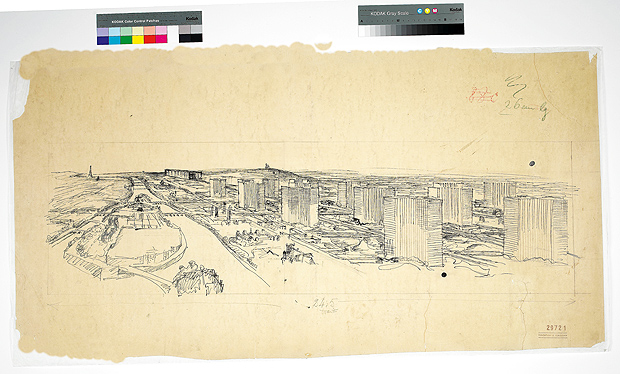Schwarz
View current page
...more recent posts
lower nazareth elementry school construction photos
via things
In 2005 I took part in a head-to-head debate on "the legacy of Modernist architecture" at a political conference. I was arguing "for". To my opponent, a Scottish architect, my citations of Bruno Taut and Berthold Lubetkin were irrelevant. Modernism was fundamentally about the baleful influence of one man: Le Corbusier. When he began by describing him as a "Swiss psychotic", it was obvious this was not going to be subtle.
Some will perennially blame Charles-Edouard Jeanneret for every under-serviced tower block, but the many discussions of Le Corbusier: the Art of Architecture - now at the Barbican, after a spell in Liverpool - have shown the solidification of a common-sense consensus. It is customary to divide his work into three facets - the city plans and collective blocks (mostly bad and "totalitarian"), the purist villas (good, albeit disturbingly bare and technocratic) and late expressionism, especially the Ronchamp church (unreservedly good, the work of a genius - the "Picasso of architecture"). This reflects neatly how architecture is perceived today - the Modernist notion of the architect as improver of mankind's lot is replaced by the superstar designer of three-dimensional logos. Le Corbusier was unquestionably adept at that, from the trademarked Modulor Man to the Chandigarh Open Hand, now a city emblem used as a stamp on the local driving licences.
By presenting an all-encompassing exhibition of the architect as Renaissance man, The Art of Architecture might seemingly offer a corrective to these pat divides. Here is a highly un-purist mass of stuff - models, paintings, magazines, films, chairs, found objects, plans, adverts, saucy postcards. Yet this chameleon and dialectician can't quite be united into a consistent whole, and the last thing you will find here is "development" in his work, ever progressing and refining itself (as one might in an exhibition devoted to, say, Mies). Instead there are breaks and ruptures. One would have to have absurdly catholic tastes to approve of everything, and only the most dedicated architectural neocon could hate it all. If there is any narrative here, it runs from an early immersion in a Mediterranean Classicism, to the right angles and urban visions of the 1920s, a brief flirtation with constructivism, and then from the mid-1930s onwards, an increasingly organic conception of form.
mudhoney 3/??/89 pyramid club nyc
The 42,000-square-foot building, smack dab in the heart of Manhattan’s garment district, has 11 stories and 70 rehearsal studios, most of which are about 350 square feet. Since its inception in 1979, the building has enjoyed 100 percent capacity, according to Lerner, and averages about 150 bands; many bands sublease their space to other musicians. Among the artists who have called The Music Building home at various times in their careers include Madonna, Interpol, the Strokes and the New York Dolls (pictured).
“Part of what our artists pay for is the peace of mind that their most prized possession, their equipment, is safe and secure,” Lerner said, adding that the studios feature steel doors and heavy duty locks.
Rents average between $1,300 and $1,600 per month, and musicians have 24-hour, seven-day-a-week access to building. Lerner said the most popular rehearsal time seems to be after 10 pm, and passersby can hear full-on jams at 2 am.
“Manhattan is really pushing out a lot the cultural facilities throughout the city,” Lerner said, alluding to CBGB’s, which featured many artists who have rehearsed at The Music Building, such as the Dolls and Patti Smith, among others. “We’ve been able to maintain the building as a rehearsal space and make it profitable financially, partly because there’s a true need for it. As long as there are artists who want to play and practice at various times, there will be a need for us.”
shredded $150 us dollars
dallas cowboys practice facility collapse
She pointed out the parlor and a living room lined with Cheever’s books (an eclectic collection that includes his friends Bellow, Updike and Lauren Bacall), but curiously there is no study. He wrote on an Underwood typewriter or portable Olivetti in a guest room, his daughter Susan’s room after she moved out, and in a small room above an Ossining barbershop that he rented for a time.

